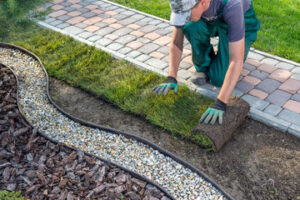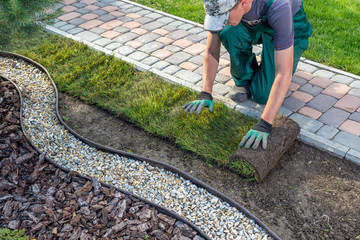Greensboro Landscaping can improve the look and feel of your property and make it more livable. Various elements like lawn care, trees, and walkways are used to enhance the beauty of your yard and provide a relaxing environment.
Weeding and regular mowing are part of lawn care. A soil test can help you determine the optimum mix of grass, shrubs and flowers for your climate.
A beautiful lawn can make your house look more inviting, and it can also increase the value of your property. But it’s important to consider the impact of your landscaping on the environment, as well as your budget and maintenance time. For example, if your landscape contains plants that are invasive, they may spread beyond the areas you want them to grow and disrupt the ecosystem. Using native plants can help to reduce the need for harsh chemicals and pesticides.
Most modern lawns are monocultures, dominated by a single species of grass. This type of landscaping requires a lot of water, fertilizer, and chemical weed killers to maintain a uniform appearance. These chemicals are harmful to native plant populations, soil microbes, and wildlife, and they can run off into the water supply, causing harm to humans and animals.
Lawns provide many environmental benefits, including providing shade, filtering water, and reducing erosion. They also promote a healthy environment by converting carbon dioxide and other pollutants into oxygen. In addition, they act as a cooling mechanism by absorbing heat and releasing moisture through a process called evapotranspiration.
In the past, people grew their own vegetables and other fruits on large plots of land. However, these days, people have limited time and space to garden. To save time and money, many people choose to have their lawns maintained professionally. Unfortunately, this can be a waste of resources and contribute to the problem of over-fertilization. In the long run, this leads to an imbalance in soil nutrients, which can result in diseases such as dollar spot, brown patch, and summer patch.
Besides being an eyesore, over-fertilized lawns can also lead to water pollution. Excessive phosphorous and nitrogen can run off into lakes, rivers, and streams and cause water quality problems. This is also a threat to fish and other wildlife.
Creating an eco-friendly landscape is possible by planting shade trees, shrubs, and flowers, as well as adding a rain garden or wild area. These can help to keep the soil cool, prevent flooding, and reduce erosion. In addition, choosing pollinator-friendly and native plants can help to eliminate the need for harmful pesticides and herbicides.
Planting beds
A planting bed is a great way to add color, texture, and interest to your landscape. They can also serve as a focal point in your landscape design. You can choose from many different types of planting beds, including shrub islands, perennial flower beds, and vegetable gardens. To make your landscape more sustainable, use plant species native to your area. This will minimize the need for water and fertilizers. It will also provide you with a natural way to deal with runoff and erosion.
When designing your planting beds, it is important to keep in mind the principles of scale and proportion. The size of a plant in relation to other plants should be taken into consideration, as well as the color palette and the design elements used in the garden. These elements help create a sense of unity and harmony in your landscape.
In addition, when constructing your planting beds, consider the maintenance needs of the plants you want to include. This will help you decide how much work and expense your garden will require. For example, a high-maintenance garden with many perennials and annual flowers will need more frequent pruning, watering, and mowing than a low-maintenance landscape with grass and only a few beds.
Before beginning a landscaping project, it is important to check with local authorities for information about buried utility lines. This can save you a lot of trouble in the future. You should also make a rough sketch of the backyard and mark where the beds will be located. Once you have done this, you can start preparing the soil for your planting beds.
When planting a new bed, it is recommended that you make a deep bed to promote good root growth. You can also use organic material such as manure or compost to improve the quality of the soil. It is also a good idea to add some organic matter to the existing beds, especially if you are planting vegetables or other edibles.
You can also add a layer of mulch to the beds to protect them from the winter elements and to maintain moisture. You can also use a layer of shredded leaves or hay for the same purpose. Avoid using weed barrier fabric in planted beds, as it will prevent the roots of the plants from getting adequate oxygen and can cause them to die prematurely.
Irrigation systems
Irrigation systems help maintain healthy, attractive landscapes by supplying the correct amount of water to plants. When properly maintained, irrigation systems are an economical way to reduce labor costs and to minimize soil erosion. A well-designed and efficient system can also help improve the health of your landscape by preventing overwatering and underwatering. A good irrigation system should be designed to meet your site’s needs and climate, and it should be inspected regularly to ensure that it is working correctly.
If you have a surface irrigation system, it is important to check it frequently for leaks and to inspect the sprinkler heads for wear and damage. A good time to do this is when the weather is changing, such as in the spring or fall.
A drip irrigation system is another option that conserves water by delivering it directly to the plant’s root zone, rather than spraying on or off the leaves and soil surface. In addition to preserving water, this method also conserves soil nutrients by avoiding runoff and evaporation. A drip system can be installed under turf, in planting beds, or in xeric areas.
If your irrigation system includes rotor or spray heads, consider replacing older heads with new, more efficient ones. The rate of delivery varies among different heads and between manufacturers. For even distribution, the heads should be the same kind throughout the irrigation zone.
It is also a good idea to consider adding a rain or weather sensor to your irrigation system, which shuts off your watering schedule when rainfall is sufficient. This simple and inexpensive device can save a lot of water, especially in the spring and fall.
A smart controller, which uses local weather information and your plant watering needs to create a customized watering schedule, is another option for saving water. You can find these types of controllers online or at some garden centers and hardware stores. Some offer a mobile app to set the controller from your smartphone. If you are considering upgrading your irrigation system, consult with your water utility to learn if there are rebates available for the purchase and installation of these devices.
Lighting
Landscape lighting elevates the beauty of your property by adding a warm, inviting glow to outdoor areas after dark. It also makes your yard safer and more usable. From path lights that improve walkway visibility to accent lighting that highlights unique features, the possibilities are endless. However, it’s important to understand the basics of landscaping lighting before you install your own system. This includes understanding the different types of lighting, as well as the wiring and power supply options.
During the installation process, it’s important to create a detailed lighting plan and to carefully map out the route of your wires. It’s also a good idea to temporarily set up your fixtures and test them at various times of the day to get an accurate sense of their effects. This step will help you avoid mistakes and ensure that your lighting design is effective once it’s installed.
It’s also important to protect your landscape lighting from the elements. A properly maintained lighting scheme can last for years, but it’s essential to check for signs of damage periodically. Identifying potential problems early will save you money and prevent costly repairs in the future.
To keep your landscape lighting system in tip-top shape, consider using light shields and coverings to protect them from rain or snow. In addition, regularly inspect your cables for frayed ends or other signs of damage. Using waterproof wire connectors can also help prevent moisture from damaging your fixtures.
Keeping your landscape lights in top condition is especially important during the fall, when they may be exposed to harsh weather conditions. Inspect your landscape lights for signs of damage and make any necessary repairs promptly to ensure they continue to function effectively throughout the season.
It’s also a good idea to clean your fixtures frequently to remove dirt, dust, and cobwebs. This will not only improve the aesthetics of your landscape lights but will also extend their life and efficiency. Rinsing your landscape lights with water will help remove any mineral deposits, and you can use a non-abrasive cloth or CLR cleaner to wipe down the lenses.

